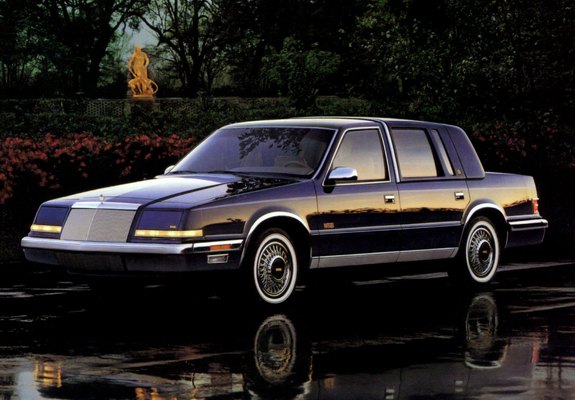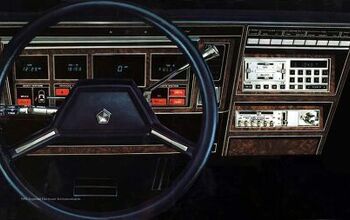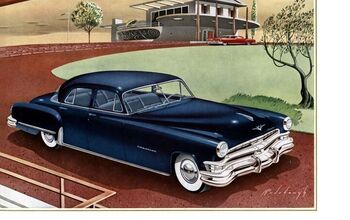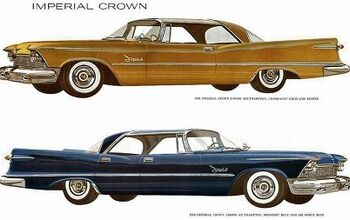Rare Rides Icons: The History of Imperial, More Than Just a Car (Part XXI)

We find ourselves at the final two installments of the long-running Imperial series today. It’s been almost six months since the first Imperial entry, when a new model was dreamt up by Chrysler’s founder as competition for the likes of Pierce-Arrow and Studebaker. The Imperial name outlived most of the Twenties competition it was designed to beat, though along the way it drifted both nearer and further to the original mission. The concluding entrant into the Imperial lineage was definitely the weakest ever. K-car time, commence!
After Imperial took a Seventies brand hiatus, the all-new Imperial personal luxury coupe of 1981 was created by Chrysler’s chief commander Lee Iacocca. Though it looked modern and was technically advanced, it was also technically too complicated and reliability suffered. And seeing as Imperial was a standalone car (not badged as a Chrysler), Iacocca gave it a standalone, bespoke-type price that was higher than its well-established competition at Lincoln and Cadillac. It flopped, despite a Frank Sinatra trim.
The 1983 Imperial was the last ever to exist as an independent marque from Chrysler. Even though Imperial’s coupe outing was a failure, the contemporary K-car and its many variants (including the revolutionary Caravan) were not, and saved Chrysler’s hide. Iacocca was delighted and praised to high heaven for the K-car, and never wanted to let it go. So entranced by the K and all its platform derivations was he that he sought another resurrection of the Imperial name. The automotive world was moving on from the broughamed, excessively trimmed sedans of the Eighties but Lee would hear none of it.
Fortunate product timing at other domestic luxury brands helped make the case for a super luxurious K offering. Even the likes of Cadillac went majority front-drive in 1985, and Lincoln followed suit with the 1988 Continental which was front-drive and gasp had six cylinders.
And so development began in the latter part of the decade on another new Imperial. It was the first car with an Imperial badge since 1954 that didn’t carry its own marque: This Imperial was part of Chrysler’s lineup, to be presented with its standard and lesser wares in marketing materials and ideology. Let’s talk platforms.
As mentioned, the new Imperial was a version of the K that underpinned just about every front-drive Chrysler vehicle between 1981 and 1995. Among early developments in the platform were lengthening exercises, at the behest of Iacocca. Chrysler needed larger cars, and the easiest, simplest way to do that was to stretch the K a bit more, like Silly Putty.
There were always midsize K cars, but the term “midsize” kept getting larger throughout the Eighties. K turned into the E in 1983 with cars like the midsize E-Class and New Yorker and then was lengthened again in 1988 into the C. For reference, a K was a 100.3-inch wheelbase, while the E cars were 103.3 inches, and the C was 104.3″, then 104.5″ ultimately. And yes we do need a Rare Rides Icons piece all about K; it will probably run for a year or so.
On the C platform (renamed to AC in 1989) were the Dodge Dynasty and the Chrysler New Yorker. Worth noting, Canadians received the awful Dynasty with a different grille, branded as a Chrysler. The C cars sold well and remained on offer through 1993 if you can believe it. But Iacocca wanted a full-size luxury car. The company needed new content that was large and in charge at dealers, as the M-body Fifth Avenue was mercifully discontinued after the 1989 model year. Side note: There’s another series, Dodge Diplomat and company.
Thus, two new cars were developed on the new Y version of K, a platform sometimes labeled as AY. The volume seller of the two Y cars would be the Chrysler New Yorker Fifth Avenue, while the exclusive halo version was the Chrysler Imperial. The Fifth Avenue was a direct replacement for the deceased M-Body, as the name had represented the most luxurious sedan Chrysler offered for some time.
The C’s 104.3-inch length was stretched quite a bit for Y-body duty, to 109.6 long inches. That figure actually trumped the wheelbase of the Lincoln Continental competition by about half an inch. The extra wheelbase supported an Imperial that stretched a full-size 203 inches, which was also comparable to the Continental’s 205.1 inches. But where the Imperial couldn’t compete was on width. Engineers were limited by Y’s compact basis on how wide it could go. Thus, the Imperial for 1990 was 68.9 inches wide, while the Taurus-based Continental spanned 72.7 inches. And those inches mattered when one was talking room for double-breasted suits and shoulder pads. Overall height for the Imperial was 55.1 inches.
Mechanically, the Imperial was the exact same as the Fifth Avenue. Both cars used Chrysler engines that were not Mitsubishi influenced. Base power came from the 3.3-liter EGA V6, while the upmarket option was the 3.8-liter EGH V6. Only the 3.3 was available for the Imperial’s introductory year, as the 3.8 was still in development. EG was a new engine family from Chrysler, and both engines were found in Chrysler minivans through 2010, and the Jeep Wrangler through 2011. The 3.3 was good for 150 horsepower, and the 3.8 made the same power but additional torque (213 lb-ft versus 180 in the former). The 3.3 engine was shared by the Dynasty and standard New Yorker, but the 3.8 was exclusive to New Yorker and the Imperial.
It’s important to talk pricing against the competition before we get to the beautiful exterior and interior of the final Imperial. The Eighties Imperial was launched at the start of a recession and inflationary period, and as consumers were moving on from both large cars and the personal luxury coupe ideal of the Seventies. The Nineties Imperial was launched against some stiff front-drive competition, but was at a big price and prestige disadvantage, both from the competition and amongst siblings. The call was coming from inside the house.
In 1990, the Dodge Dynasty asked $13,515 ($30,097 adj.) as a base model, or $14,915 ($33,215 adj.) as an LE. The more luxurious New Yorker started at $16,916 ($37,671 adj.) as a vinyl-roof-free Salon and stepped to $19,315 ($43,013 adj.) as a Landau. In long-wheelbase format with the Marc Cross leather package the New Yorker was $21,924 ($48,824 adj.), and the extra trim of the Fifth Avenue was slightly more at $21,945 ($48,870 adj.). Imperial arrived in one standard trim, loaded with everything except the visor-mounted car phone for $25,545 ($56,887 adj.). It was a hefty price to pay for the unique front and rear clips of the Imperial, on a car that was otherwise identical to the Fifth Avenue in trim, and shared most other things with the Dynasty.
Against the competition, the Imperial was cheaper than the V8-powered DeVille’s $28,090 ($62,555 adj.), while the Continental was dearer at $29,808 ($66,381 adj.) in base trim. But both the Cadillac and the Lincoln were a bit more in line with what the late Eighties luxury customer wanted and looked much more modern than the laden pontoon boat that was the Imperial. Not even positive MotorWeek had much nice to say about the Imperial.
So the 1990 Imperial was a discount luxury ride. But was it discounted enough? Maybe the allure of the name and special exterior looks that tied Imperial to its lineage would appeal to more customers than the modern, simplified offerings from other domestic competition. We’ll find out next time when we close out this series.
[Images: Chrysler]

Interested in lots of cars and their various historical contexts. Started writing articles for TTAC in late 2016, when my first posts were QOTDs. From there I started a few new series like Rare Rides, Buy/Drive/Burn, Abandoned History, and most recently Rare Rides Icons. Operating from a home base in Cincinnati, Ohio, a relative auto journalist dead zone. Many of my articles are prompted by something I'll see on social media that sparks my interest and causes me to research. Finding articles and information from the early days of the internet and beyond that covers the little details lost to time: trim packages, color and wheel choices, interior fabrics. Beyond those, I'm fascinated by automotive industry experiments, both failures and successes. Lately I've taken an interest in AI, and generating "what if" type images for car models long dead. Reincarnating a modern Toyota Paseo, Lincoln Mark IX, or Isuzu Trooper through a text prompt is fun. Fun to post them on Twitter too, and watch people overreact. To that end, the social media I use most is Twitter, @CoreyLewis86. I also contribute pieces for Forbes Wheels and Forbes Home.
More by Corey Lewis
Latest Car Reviews
Read moreLatest Product Reviews
Read moreRecent Comments
- Alan Well, it will take 30 years to fix Nissan up after the Renault Alliance reduced Nissan to a paltry mess.I think Nissan will eventually improve.
- Alan This will be overpriced for what it offers.I think the "Western" auto manufacturers rip off the consumer with the Thai and Chinese made vehicles.A Chinese made Model 3 in Australia is over $70k AUD(for 1995 $45k USD) which is far more expensive than a similar Chinesium EV of equal or better quality and loaded with goodies.Chinese pickups are $20k to $30k cheaper than Thai built pickups from Ford and the Japanese brands. Who's ripping who off?
- Alan Years ago Jack Baruth held a "competition" for a piece from the B&B on the oddest pickup story (or something like that). I think 5 people were awarded the prizes.I never received mine, something about being in Australia. If TTAC is global how do you offer prizes to those overseas or are we omitted on the sly from competing?In the end I lost significant respect for Baruth.
- Alan My view is there are good vehicles from most manufacturers that are worth looking at second hand.I can tell you I don't recommend anything from the Chrysler/Jeep/Fiat/etc gene pool. Toyotas are overly expensive second hand for what they offer, but they seem to be reliable enough.I have a friend who swears by secondhand Subarus and so far he seems to not have had too many issue.As Lou stated many utes, pickups and real SUVs (4x4) seem quite good.
- 28-Cars-Later So is there some kind of undiagnosed disease where every rando thinks their POS is actually valuable?83K miles Ok.new valve cover gasket.Eh, it happens with age. spark plugsOkay, we probably had to be kewl and put in aftermarket iridium plugs, because EVO.new catalytic converterUh, yeah that's bad at 80Kish. Auto tranny failing. From the ad: the SST fails in one of the following ways:Clutch slip has turned into; multiple codes being thrown, shifting a gear or 2 in manual mode (2-3 or 2-4), and limp mode.Codes include: P2733 P2809 P183D P1871Ok that's really bad. So between this and the cat it suggests to me someone jacked up the car real good hooning it, because EVO, and since its not a Toyota it doesn't respond well to hard abuse over time.$20,000, what? Pesos? Zimbabwe Dollars?Try $2,000 USD pal. You're fracked dude, park it in da hood and leave the keys in it.BONUS: Comment in the ad: GLWS but I highly doubt you get any action on this car what so ever at that price with the SST on its way out. That trans can be $10k + to repair.




































Comments
Join the conversation
Exhibit "A", in the case of "How Quickly Can a Company Destroy a Brand"
Best part of these stretched K-cars was they introduced Chrysler's new, 4 speed Automatic Transaxle with electronic controls, named UltraDrive. Coming from the company who developed the "Lean Burn System" in the '80s and the self-immolating Electronic Ignition modules in the '70s, no idea why expectations were high. The Ultradrives quickly displaced the GM transaxles as the most troublesome and self-destructive transmissions developed. The Ultradrive moniker was quickly dropped and Chrysler replaced thousands of these trans. in sedans, minivan's and convertibles. My elderly aunt had the New Yorker Landau version, in the whopping 7000 miles she drove in 2 year in billiard table flat south Florida, the "Landau de'Elegance" as we named it ate two transmissions and she lost total confidence in her car. Remarkably she took another bite at the apple, replacing the faulty K-car with a new Chrysler Concorde, which was an exceptional car plagued with lots of first year faults but overall a pretty decent car. I'll give Lido credit for saving Chrysler and paying back the loans he took out, but he milked that K-platform way too long trying to turn it into something it was never intended to be.